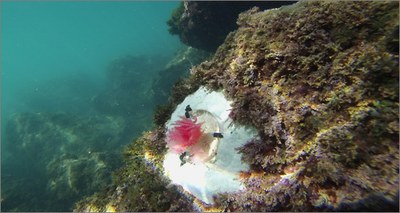Environment: 3D lookalike algae to study seabeds affected by climate change
13/12/2018
Artificial algae "lookalike" of a coralline alga, a key species of the Mediterranean, could be used in ecological restoration projects to restore natural ecosystems compromised by the anthropic impact. These are the first results of a project conducted by ENEA, University of Portsmouth and CNR
 Artificial seaweeds "lookalike" of a key species of the Mediterranean could be used as tools to "restore" natural ecosystems compromised by climate change. This is what the first results of the project "Will coralline algae reef mitigate climate change effects on associated fauna?", conducted by ENEA with the University of Portsmouth and the CNR, suggest.
Artificial seaweeds "lookalike" of a key species of the Mediterranean could be used as tools to "restore" natural ecosystems compromised by climate change. This is what the first results of the project "Will coralline algae reef mitigate climate change effects on associated fauna?", conducted by ENEA with the University of Portsmouth and the CNR, suggest.
After being designed, printed in 3D and transplanted on the bottom of the Bay of Santa Teresa (La Spezia), the 60 mimic algae of the coralline E. elongata were analyzed through snorkeling surveys, "night lab" (i.e. 24h monitoring of chemical-physical parameters on the reef), sampling and microscopy analyses, with the aim of testing their suitability for colonization by marine organisms.
After 5 months on the depths of the Bay of Santa Teresa, 42% of the "lookalike", or "mimics", survived. As the composition of the fauna associated with the artificial algae is concerned, the studies show a similarity with that associated with natural reef for about 61%[1], confirming also the suitability of the 'mimics' to attract and host a fauna comparable to that which colonize the natural algae. During the study the researchers recorded two heat wave events, intense heat waves with peaks above 26 ° and average temperatures above 24 °, to which the 'mimics' and the natural reef were exposed, which testify to the occurrence of anomalous climate warming events.
"This coral alga is considered an 'ecosystem engineer'. In addition to promoting biodiversity and producing clean 'carbon', the so-called blue carbon, which is produced through photosynthesis, it’s of enormous importance for the life and survival of many organisms, plants and animals", Chiara Lombardi, at the ENEA Department of Sustainability of Productive and Territorial Systems, pointed out.
With a structure made of calcium carbonate and erect but flexible fronds, this precious coralline algae can grow both on natural and artificial rocky substrates and survive out of the water for lenghts of time (for example due to tidal lowering), and withstand strong variations in temperature, salinity and pH. These characteristics make its reefs ideal habitats for the life of numerous marine organisms (crustaceans, polychaetes, echinoderms, bryozoans) that in its branches find shelter from unfavorable environmental conditions and hiding from predators, and also a source of food and nursery areas for reproduction, playing a key role in the environment resilience to climate change.
The first results of the project, funded by the Royal Society (International Exchange Grant RS-CNR), were presented with a video by Matteo Nannini, ENEA doctoral candidate, awarded best speed talk at the LTER network conference “The LTER-Italia network, towards an open and sustainable infrastructure”, for the sharing of knowledge and data, the connection among disciplines and the dissemination of scientific outcomes.
"The Santa Teresa Center is part of the LTER network thanks to the marine weather observatory and the long-term biological monitoring that our colleagues have conducted for over 20 years on valuable ecosystems vulnerable to climate change in the Gulf of La Spezia", Roberta Delfanti, Head of the Protection and Valorisation Division of the Natural Heritage, explained.
"The 42% rate of " mimics" survived to the exposure to the natural environment shows that, although the properties of the material used were similar to those of the seaweed in terms of tensile strength, the stress from the" fatigue "imposed by the periodicity of the 'wave has been important ", Chiara Lombardi explained. "The other interesting element was the occurrence of two events of Heat Wave, between June and August 2017, which testifies to the occurrence of anomalous events of climate warming in progress. For this reason, in addition to the study of the biological communities present, we hope to be able to continue the climate monitoring "
In order to fully understand the climate change mitigation effect by the natural seaweed on the associated fauna, the researchers recreated at the ENEA Laboratory of the marine environment research center of S. Teresa, a critical scenario such as that foreseen for 2100 by the International Panel of Climate Change (IPCC), when ocean acidification will bring the pH of water to a 7.7 value: natural reefs and 'mimics' were placed in tanks and tested with values of pCO2 - current and expected for 2100 - and increased temperatures (heat waves). The results of the experimental phase are expected by 2019.
"The reef-forming coralline algae belong to a group of organisms that plays an important role in" buffering " the pH decrease, creating a micro-environment that could help some species to resist climate change", Federica Ragazzola at the University of Portsmouth, explained. "When the waters become more 'acid', these coral reefs, through photosynthesis and slowly dissolving, increase the pH protecting the organisms living inside".
For more information please contact
Chiara Lombardi, ENEA – Biodiversity and Ecosystem Services Laboratory, chiara.lombardi@enea.it
Lab page: https://medclimalizers.wordpress.com
[1] Bray-Curtis similarity index
